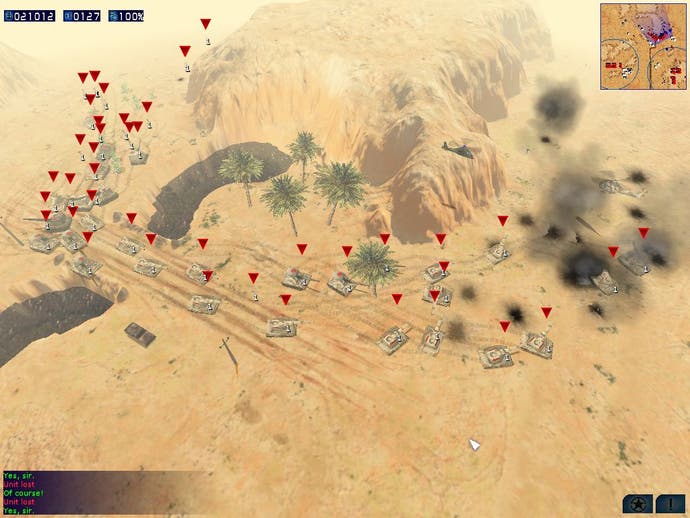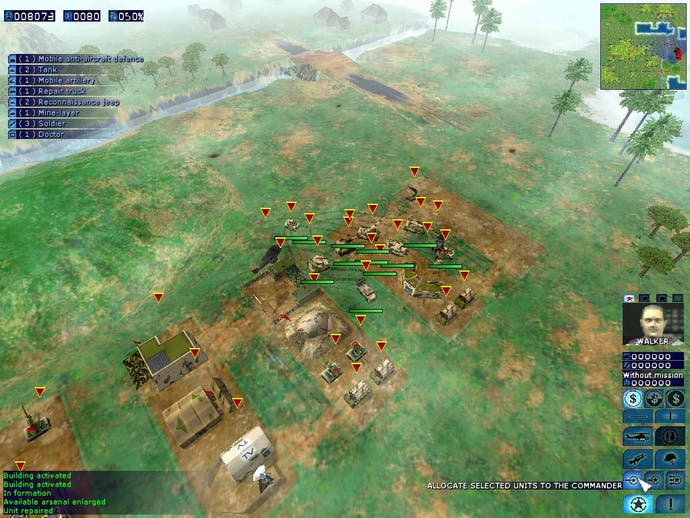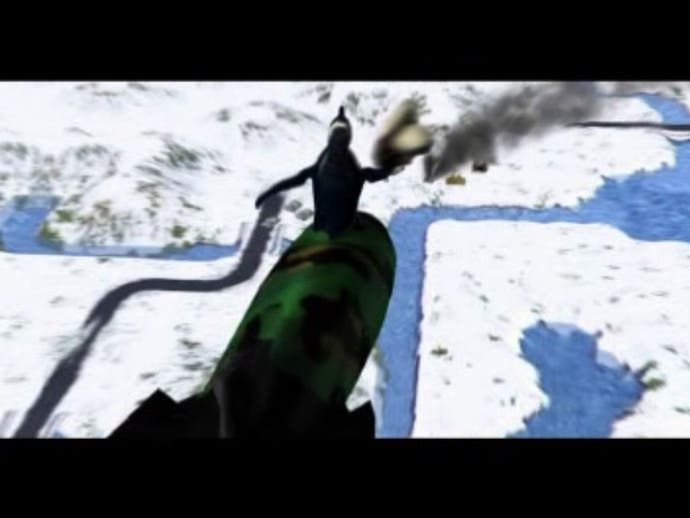Conflict Zone
Review - EuroGamer sends in the peacekeepers to deal with this unusual 3D strategy game
While most real-time strategy games are set in some kind of bloody total war, Conflict Zone is a very different beast. In 2010 the International Corps for Peace (ICP) is struggling to keep warring factions apart and rescue innocent civilians caught up in the crossfire, while a shadowy organisation known as GHOST stirs up trouble behind the scenes.

War and Peace
Working for either the UN-style do-gooders or the corporate-run terrorists, you will find yourself battling your way across the deserts of North Africa, the mountains of Kashmir, the rice paddies of south-east Asia and the remains of the Soviet Union. And while there is still the usual array of "build a base, destroy the enemy" style missions found in any such strategy game, you will also be called upon to sabotage chemical weapons factories, escort VIPs, rescue prisoners, and defend your studio while television crews arrive to interview survivors of a massacre.
Which brings us to the game's main innovation. While every war since Vietnam has essentially been run by and for the media, Conflict Zone is the first real-time strategy game to try to mirror this reality. As such the outcome of a battle depends not only on out-fighting the enemy, but also on winning the war on the home front. All but the most basic of units and buildings require a certain approval rating, and the higher your popularity the more advanced the troops you can construct. In the case of GHOST this means filming your battles for the TV, with each hard-fought victory broadcast live from your media center adding to your popularity. For the ICP it means rescuing local people from the warzone, locating and defusing mines, and generally being sickeningly nice to everybody who isn't shooting at you.

The Buck Stops Here
Needless to say this means that the GHOST campaign is a lot more fun than the ICP one. There is nothing more annoying than garnering enough popularity to allow your factories to start churning out some powerful new weapon, only for a news report to flash up saying that "civilians are being targeted", leading to an instant drop in approval ratings. This is especially true thanks to the vomit-inducing degree of moral outrage present in the female TV presenter's voice as she catalogues each supposed failing of your humanitarian campaign.
It also doesn't help that whenever something goes wrong, you get blamed for it. If GHOST shoots down one of your rescue helicopters or blows up a refugee camp, you lose popularity. If you don't rescue the civilians quickly enough, the media complains. If the enemy herds a group of civilians into the midst of a battle or chases them into a minefield, you get blamed if they die. If you blow up an enemy recruitment camp, where the locals are brainwashed into fighting for the terrorists, you get accused of destroying a refugee camp. If one of your soldiers steps on a mine, you lose popularity. Hell, if a GHOST soldier gets blown up by one of his own mines, you still seem to end up taking the blame. Before long you'll find yourself screaming at the monitor "look, it wasn't my fault". Or maybe that's just me...
It might be realistic (witness the Gulf War or Kosovo) and it was certainly a brave attempt to try something radically different, but I found it to be rather irritating in practice. It's all too easy to lose the PR war through no real fault of your own, and once that happens the game is as good as over. However low your popularity is, you can always build more refugee camps and rescue helicopters, but if the nearest town is swarming with enemy units that shoot you down as soon as you try to help anybody there's not much you can do about it. And you lose more popularity when the helicopter explodes.

Capture The Civilian
Playing as GHOST on the other hand, public opinion is based entirely on your performance in battle, assuming of course that you have cameramen there when you win a fight. This means that your popularity will generally keep rising throughout a mission unless you really foul things up.
The resource system is also different for the two factions. Both sides get a number of Command Points each second which can then be spent on new units and facilities, and both sides effectively "harvest" civilians. But while the ICP gets a simple one-time cash reward and a popularity boost for each civilian successfully airlifted to their refugee camp, GHOST gets an increase to the rate at which it earns Command Points, and your enlistment camp also turns the civilian into a random infantry unit for free. On the other hand, if the ICP loses battles its popularity isn't harmed (as long as no civilians are harmed), while GHOST will earn less and less money as it keeps losing battles. Sadly none of this seems to noticeably effect your AI opponent though.
The game's other main innovation is the commander system, which helps take some of the micromanagement out of real-time strategy. Up to four leaders are available to you by the end of a campaign, each with its own personality and speciality. You can assign units and resources to them and then order them to attack or defend a location or to build up your base, with varying results. Attacks tend to be little more coordinated than if you had simply selected all the units, clicked on the destination and left them to it, but commanders do make good use of terrain and chokepoints when defending a base, covering all the entrances effectively and taking advantage of any high ground. Their only failure is being too static, and it's not unusual to see enemy troops breaking into your base while a defending commander keeps his surviving soldiers covering another entrance. As long as you don't expect too much from them though, they can lift some of the burden of command from your shoulders and leave you free to focus on overall strategy or a different part of the battlefield.

Naked Gun
With or without the help of your commanders, you can control upwards of two hundred units. You can even call in air raids in the later stages of the game, which can prove devestating. Things tend to slow down somewhat in the midst of a big battle, but the range of units and buildings on offer is certainly generous, with infantry, helicopter gunships, tanks, mobile artillery, jeeps, anti-aircraft units, submarines, turrets, radar towers and commando troops available. Not all units are created equal though - I've yet to work out what grenadiers or soldiers are good for, apart from acting as cheap cannon fodder and getting squished by tanks.
Seeing hordes of infantry getting run over Carmaggedon-style or reduced to their constituent parts by artillery fire isn't the only source of amusement in the game. The developers have decided to lighten the tone in the cutscenes, which are downright surreal and lampoon everything from Dr Strangelove and Lawrence of Arabia to The Matrix and Stargate, not to mention those classic Hamlet cigar adverts. The ICP's introductory cinematic alone features a shark, a herd of cattle, a disco dancing officer and a guitar-playing rastafarian in the background, although not all at once we hasten to add. The result is incredibly funny at times, but doesn't quite gel with the rest of the game.
It's all a bit hit and miss really. The interface is simple and should be easy to use, except that it is unresponsive in the heat of the action and suffers from annoying bugs and quirks. For example, the unit grouping system unloads troop transporters when you select them by hotkey, and soldiers stop dead in their tracks whenever you add another unit to their group. The behaviour system is more trouble than it's worth as well. In strict mode units do exactly what you tell them to but don't show much initiative, sitting still while artillery shells fall on your base nearby. In aggressive mode though they will attack and chase any target visible on the entire battlefield, completely ignoring your orders as soon as they make contact with the enemy.
Conclusion
Conflict Zone tried to do something different in what is normally a highly derivative genre, but unfortunately the new features don't work quite as well as they perhaps should have done, and the game can't quite decide whether to play it for laughs or not. The single player campaign is utterly linear, and the way the background story is presented between missions via TV news reports is tedious and disjointed. The difficulty settings don't seem to make much difference either - the early missions are mostly straightforward, but the second half of each campaign is incredibly difficult even on "easy". The skirmish and multiplayer modes go some way towards rescuing the game, with a wide range of maps and support for up to eight human or AI players, but this could have been much, much more.
All in all a nice idea, but poorly implemented. We can only hope that MASA or another company takes the innovations introduced in Conflict Zone and does them the justice that they deserve. In the meantime, "public opinion is not in your favour - act with caution".

